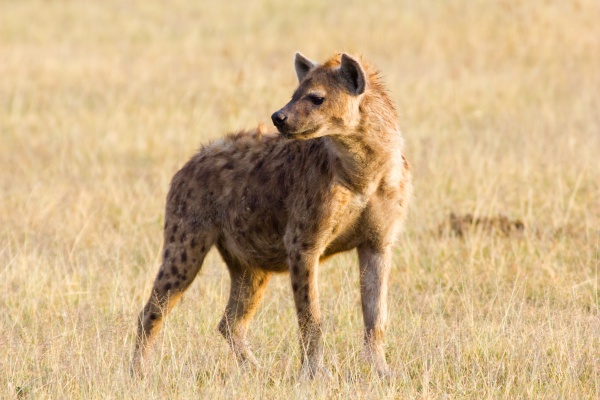Facts About Spotted Hyaena
The spotted hyena, often referred to as the laughing hyena, is the sole extant member of the genus *Crocuta* and is native to Sub-Saharan Africa. According to the IUCN, the species is categorized as "least concern" due to its substantial population, estimated between 27,000 and 47,000 individuals, and its wide distribution. Nevertheless, these hyenas face significant threats from habitat loss and poaching outside protected areas. Interestingly, the spotted hyena may have originated in Asia and roamed Europe until the end of the Late Pleistocene.
Physically, the spotted hyena is the largest member of the Hyaenidae family. It has a bear-like build, rounded ears, a spotted coat, specialized dentition for both cutting and crushing, fewer nipples relative to other mammals, and females possess a pseudo-penis without an external vaginal opening. Socially, spotted hyenas are among the most social of the Carnivora, living in large, intricate groups with behaviors that resemble those of certain primates. However, their social structure is characterized by competition rather than cooperation, with access to resources determined by dominance hierarchies. This is a matriarchal society where females are larger and dominate males.
Spotted hyenas are highly adaptable carnivores capable of both hunting and scavenging. They can digest skin, bone, and other tough animal materials, rendering them highly efficient. They hunt alone, in small groups, or in large parties, often running through herds to single out prey, which they can chase at speeds of up to 60 km/h.
Throughout history, spotted hyenas have interacted with humans since the Upper Paleolithic period and are frequently depicted in ancient art. They have a predominantly negative reputation in Western culture and African folklore, often perceived as ugly, cowardly, greedy, gluttonous, and dangerous. The IUCN's hyena specialist group notes that this negative image jeopardizes their conservation.
The scientific name *Crocuta* derives from the Ancient Greek word *Krokottas*, which traces back to the Sanskrit *koṭṭhâraka* and *kroshṭuka*. Historically, spotted and striped hyenas were often confused or distinguished by geography rather than physical characteristics. Europeans like Willem Bosman and Peter Kolben first described them in detail in the 17th and 18th centuries, with Thomas Pennant and Johann Erxleben later recognizing *Crocuta* as a separate genus.
Spotted hyenas exhibit significant variation over time and space, once inhabiting nearly all of Africa and Eurasia. Despite this, all spotted hyenas belong to a single subspecies. Research suggests they originated in Asia, with three migration events to Africa. The ancestors of *Crocuta* diverged from *Hyaena* around 10 million years ago, with their social behaviors developing in response to competition from other predators.
Anatomically, the spotted hyena is characterized by a strong neck and forequarters, a rounded rump, a wide, flat head, rounded ears, and a short tail. Females are larger than males and possess a pseudo-penis. They have a powerful bite capable of crushing bones.
Spotted hyenas live in large, matriarchal clans with complex social structures. They are territorial, defending their home ranges through vocal displays, scent marking, and boundary patrols. Mating is promiscuous, with females preferring younger males and males exhibiting submissive behavior. Cubs are born with open eyes and teeth, demonstrating aggressive behaviors shortly after birth.
These hyenas possess significant intelligence, with social behaviors and problem-solving abilities comparable to primates. They hunt a variety of prey, primarily medium to large-sized ungulates, and efficiently consume their kills. They face competition from lions, cheetahs, leopards, African wild dogs, jackals, wolves, and other hyena species.
Spotted hyenas communicate through body language and a range of vocalizations, with high-pitched calls indicating fear or submission and lower-pitched calls expressing aggression. They are susceptible to various diseases and parasites, but exposure to rabies and other infections does not significantly impact their survival.
Historically, their range included Europe, but today they are confined to Sub-Saharan Africa, predominantly in protected areas. They inhabit a diversity of environments, from semi-deserts to open woodlands and mountainous forests. The species has a complex relationship with humans, featuring prominently in African folklore and mythology, and often depicted negatively in Western culture. They occasionally prey on livestock and humans, particularly where they are accustomed to scavenging on human remains.
In urban areas, spotted hyenas can become problematic, scavenging through rubbish and preying on feral animals. They are hunted for traditional medicine and bushmeat, although this is infrequent. In captivity, spotted hyenas are relatively easy to maintain and can live up to 25 years, but they are not commonly represented in zoos. Despite their adaptability, they face significant challenges from human encroachment and negative perceptions.

 Kenya
Kenya